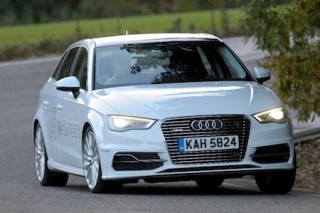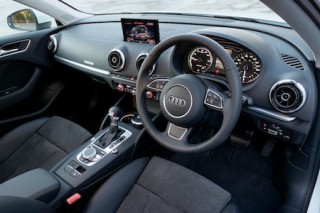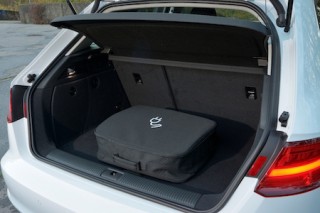 I have just had a longer driving spell with Audi’s first PHEV plug-in hybrid, the A3 Sportback e-tron.
I have just had a longer driving spell with Audi’s first PHEV plug-in hybrid, the A3 Sportback e-tron.
The A3 is Audi’s best selling model range with 45,581 sales last year putting it into the UK’s top ten sales chart for the first time. It finished the year in eighth position.
The A3 range comprises of three door hatchbacks, the five door Sportback, four door saloons and the cabriolet. Depending on the body style chosen there is a wide range of petrol and diesel engines on offer ranging from 1.2-litre TFSI petrol to the 2.0-litre diesel to the 2.0-litre TFSI petrol 300hp quattro.
But there is only one e-tron model, the high spec A3 Sportback which combines a 1.4-litre, 148bhp, four cylinder turbocharged petrol engine turbocharged petrol engine with a 101bhp electric motor and with the plug-in electricity supply function for the 8.8kWh lithium ion battery pack mounted beneath the rear seats. The electric motor is positioned between the petrol engine’s flywheel and the six-speed dual clutch automatic transmission. Total system output is 201bhp and 350Nm (258lb ft) of torque. It is priced at £29,950 after the Government’s plug-in discount.
As for performance the headline figures are an official 584 mile range, it will run on only electric power for 31 miles, top speed is 137mph and 80mph in electric mode.
During my In real life test driving spell, a 200 mile journey using mainly motorways resulted in just 45.7mpg and the return journey using A/B roads resulted in 44.5mpg and both journeys started with the battery fully charged.
On further commuter trips with the battery again fully charged, covering country roads and in-town stop-start traffic, the fuel economy was better at 88.5mpg but again was not close to the official figure. My 10 days driving road test average overall was 53mpg.
The problem I found was that the battery with its fully charged 31-mile range just doesn’t offer enough capacity to have any meaningful input on longer journeys.
It will initially give good fuel economy running in conjunction with the petrol engine but once the battery level is low the e-tron reverts mainly to using the petrol engine and the fuel economy suffers. The e-tron just does not ‘harvest’ enough electricity to top up the battery during normal driving unlike the Prius+, Mitsubishi Outlander or even its sister car – the VW Golf GTE.
The relatively small capacity battery does mean short charging times with just over two hours from a public charging point or around four hours from a domestic 13-amp plug/socket. Where the e-tron will work best is with users doing a daily commute round trip of 31-miles or less when a daily charge from a home electric supply will give better fuel economy.
If the e-tron system could ‘harvest’ more power on the overrun and braking modes it would be a more viable plug-in hybrid for more people.
Retail customers in particular will be better off buying the A3 Sportback 1.4-litre TFSI petrol 150hp Sport which can return 60mpg and costs over £7,000 less to buy and company car users could choose the 2.0-litre TDI 150hp turbodiesel Sport which is £5,700 cheaper and will return 68mpg.
Even taking into account the higher road tax or Benefit-in-Kind tax these conventional models incur they are a much cheaper proposition. With only just over 300 e-tron UK sales for the first three months of this year customers would seem to agree that the extra cost of the plug-in hybrid A3 is not worth the extra purchase cost.
 The A3 e-tron has four driving modes to select from. These are pure electric power only, another to preserve the battery power, one to increase battery power life by using the petrol engine as a generator whilst driving along and during my test period I found this reduced the fuel economy by 9mpg.
The A3 e-tron has four driving modes to select from. These are pure electric power only, another to preserve the battery power, one to increase battery power life by using the petrol engine as a generator whilst driving along and during my test period I found this reduced the fuel economy by 9mpg.
Finally there is the mode that will be used most of the time by the majority of drivers which automatically uses both petrol and electric motors according to the driving conditions.
The A3 e-tron is easy to drive, it accelerates briskly due to the low down torque of the electric motor before the petrol engine switches in giving a near seamless power delivery. There was sometimes a subtle vibration when the engine cuts in but generally it was very quiet.
With the weight of the battery pack the e-tron feels significantly heavier than conventional A3s. That extra bulk does mean it is well planted on the road and if the Comfort setting is used it was a relaxed drive at cruising speeds.
The extra weight did show up during cornering where the five door hatchback had a tendency to ‘wash out’ wider through bends than standard A3 models.
The battery pack being situated under the rear seats has meant the fuel tank has been positioned under the boot floor. Part of that compromise means that the tank has been reduced to 40-litres and the boot space to 280-litres. Around one third of the boot space is taken up by a case holding the various mains charging cables so that is another compromise.
 The interior of the car is well equipped with one relatively high level of specification for the e-tron which includes sat-nav but being an Audi there is still a long list of extra cost options which includes cruise control costing £225, Audi parking display at £250, heated front seats at £260, a panoramic sunroof at £950 and 18-inch wheels at £995 which also increase the CO2 emissions to 39g/km.
The interior of the car is well equipped with one relatively high level of specification for the e-tron which includes sat-nav but being an Audi there is still a long list of extra cost options which includes cruise control costing £225, Audi parking display at £250, heated front seats at £260, a panoramic sunroof at £950 and 18-inch wheels at £995 which also increase the CO2 emissions to 39g/km.
There is no doubt that as manufacturers are forced by legislation to reduce the average CO2 emissions of their entire range of models more use will be made of hybrid technology used in conjunction with petrol and diesel engines and so doing away with the range anxiety of electric only powered cars.
Adding the plug-in electric facility does facilitate a significant reduction in CO2 emissions and tax costs but in real-life it is not the most cost-effective A3 Sportback model available for most people.
MILESTONES:
Audi A3 Sportback e-tron, 1.4 TFSI 150hp, S tronic, 5-door £29,950 (after the Government plug-in grant).
Powertain: 1.4-litre, direct injection turbocharged 148bhp petrol engine, 101bhp electric motor, combined torque of 350Nm, 6-speed S tronic automatic transmission.
Performance: 137mph (80mph in electric power mode), 0-62mph 7.6-seconds, driving range up to 584-miles (up to 31-miles electric power only), 176.6mpg (44.5 to 88.5mpg with an overall average of 53mpg) CO2 37g/km, VED road tax £0, BIK company car tax rate 5%, zero cost London Congestion Charge.
Insurance group: 29.
Warranty: 3-years/60,000-miles.
Dimensions/capacities: L 4,312mm, W 1,785mm, H 1,424mm, boot/load space 280 to 1,120-litres, 5-seats/5-door hatchback.
For: Cleanest emission A3 model available, a low tax company car, used in the right conditions it can deliver eco-friendly frugal fuel economy but only if the mains charging facility is used, Congestion Charge free, with its petrol engine it does away with electric car range anxiety, usual Audi high quality, high spec, comfortable ride.
Against: Difficult to recommend for retail customers due to its high price over other petrol/diesel A3s, didn’t produce anywhere near the official fuel economy figure, small boot.
